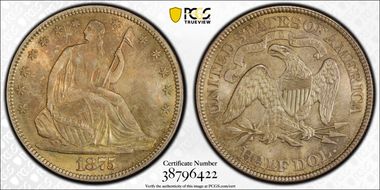Hariett Emma Hymas (1875-1980) 的钱币相册
The 1875 has a huge mintage relative to virtually every other date in the series. At over six million coins, this mintage was the largest since 1858 and it was the fourth largest of the series. This makes the 1875 Half Dollar an affordable example of the type and one which can be found with relative ease. Scores of Mint State examples exist in a range of grades from MS62 to MS64. Gems are scarce, but not rare. What is most surprising is how rare this date is in grades above MS65. One would think that a coin with such a large mintage might have survived in better condition.
Large mintage: The production quantity of trade dollars at the San Francisco Mint in 1875 was immense. Included in the monthly figures (see Summary of Characteristics) were several months' production which on their own would have been satisfactory for a year in earlier times; namely, January 695,000, April 652,000, May 535,000, October 614,000, November 517,000, and December 516,000. These numbers when added to the figures for other months comprised a total of 4,487,000 pieces, a record for the series. While the majority of such coins were exported, thousands went into circulation on the West Coast, particularly in the San Francisco area, where they traded at face value in commercial transactions. Possibly the largest exporter was the Nevada Bank of San Francisco. Mint officials rested easy, knowing that the silver-mining interests (and their congressional friends, Senators Allison and Jones and Representative Richard P. Bland) were satisfied in the knowledge that the market for the metal was strong. The Oriental demand was great, and domestically a good future awaited the continuing coinage of fractional pieces (from the dime through the half dollar), which were being minted in very large quantities to redeem Fractional Currency notes and to restore silver to United States commerce. Mint officials rested easy, knowing that the silver-mining interests (and their congressional friends, Senators Allison and Jones and Representative Richard P. Bland) were satisfied in the knowledge that the market for the metal was strong. The Oriental demand was great, and domestically a good future awaited the continuing coinage of fractional pieces (from the dime through the half dollar), which were being minted in very large quantities to redeem Fractional Currency notes and to restore silver to United States commerce. Mint State grades: In MS-65 the 1875-S is the most available of all trade dollars. I estimate that 75 to 150 or more exist. Most are decent strikes and are quite lustrous. At the MS-64 level I believe that 200 to 400 or more exist, while I estimate 500 to 1,000 or more as the population for MS-63 coins. In grades from MS-60 to 62, an estimated 1,500 to 3,000 or more survive. Many Uncirculated coins were brought to the United States from Hong Kong in the 1940s and 1950s. Most (about 80% to 90%) Mint State coins are Type I/I; the rest are Type I/II.





















